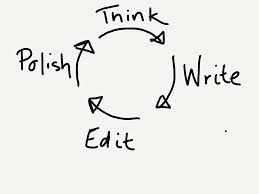
10 Apr 10 Top Tips for Productive Writing
By Katy Berrill, Monday 10th April 2017
Using the Think, Write, Edit, Polish Model as shown above, we can all become productive and effective writers. Whether you are writing a Proposal or Tender Response we all need to be productive in our writing to avoid wasted time and energy. Whilst writing may not come naturally or fit your day job these top tips will certainly make your life easier and ensure that you avoid writers block but also produce concise and compelling pieces to capture your Audiences attention.
In our work we have to write thousands of words a day which score highly for our Clients and Win More Work, so from our experience we give you what we feel are the best tips for productive writing:
Top Tips
1. Think – What are the key points you need to cover? What is being asked of you? Is their guidelines and requirements to take into consideration? What message are you trying to communicate? What tone should the response be in? What is your objective?
2. Think – About your titles and sub-titles as these are going to the Framework and Structure for your entire piece. It doesn’t matter if you are only writing a simple Response or Document, a few well-placed and well-worded headings will provide considerable value to your Reader and retain their attention longer.
3. Keep an up to date Information Library – This can be very useful to capture key points, previous text, case studies; examples and will act as a memory jog and source of inspiration.
4. Write – Get words down – You can always go back over and re-gig or shave the document down. At least you’ll have something written to work on. Use the Structure created by your Headings and Sub-headings. Write in note form to start with using bullet points – you can always go back in the edit phase and link these together to create more flowing text.
5. Writing Environment – Remove distractions, turn off emails, phones and find space to write away from others as once you get into it, you will want to just keep going. If you are interrupted frequently you will lose your train of thought and flow to the text.
6. Writing Environment – Set breaks in your time to check emails and phone calls.
7. Edit – Go back to your first ‘Think’ point and review the answers to those questions. How well have you captured these elements? Is it fit for purpose? Does it fit the Client requirements? Is it compliance with word counts?
8. Edit – Look at the structure of your document now does it need any imagery to support the text – if you ae able to can you transfer words into infographics to reduce word counts and create interest. Page after page of text can switch off a reader – unless they have specifically asked for text only Responses.
9. Polish – Say what you’ve written out loud – Making sure that what you’ve written is easy to read and makes sense.
10. Polish – Get a colleague to proof read – A second pair of eyes can be useful as when you’re engrossed in a piece of work and writing away you can miss obvious mistakes, it’s only natural. If they are trained in Proof Reading or have a particular eye for detail even better!
